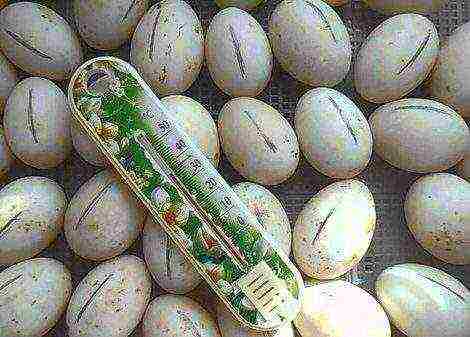Content
Description and characteristics of the bred redbro chicken hybrid
A special place in the breed breeding of chickens is occupied by the cultivation of hybrids. It is to hybrids that Redbro chickens belong, which first appeared in poultry farms more than a century ago and were bred by crossing Cornish birds with Malay fighting cocks.
The birthplace of Redbrough is Great Britainbut they are most popular with poultry farmers in France and the United States. In this article, we will take a closer look at the characteristics of redbro chickens. Let's talk about the description of redbro chickens, and also learn the secrets of raising them.
Redbro chickens: breed description
It will be extremely difficult for a beginner in the poultry business to distinguish redbro hens from ordinary domestic layers, which is largely due to the unassuming external features of the breed.
Appearance
Redbro is a large breed of birds. The head of the chicken is large, the plumage is dense. Laying hens have a short, well-defined beak and a bright red comb. The shape of the crest is leaf-shaped or pod-shaped. The earlobes are bright, making them easy to spot.
The color of the feathers is red, sometimes turning into red-brown. In rare cases, birds with white plumage are found., but this color of feathers is considered the exception rather than the rule.
Temperament
Redbro chickens are extremely accommodating, endowed with a calm and peaceful nature, which makes them easy to keep with other birds. When breeding this breed, it is better not to use cages, Redbros are extremely freedom-loving, therefore a spacious chicken coop with free walking is more suitable for their maintenance.
The minimum temperature in the hen house should not fall below 7 degrees and rise above 25. As for the rest, chickens are more than unpretentious, they are much easier to keep than other breeds, including broilers.
Industrial farms or home gardens
Redbro - chickens are versatile, birds feel at ease both on an ordinary personal plot and on a large poultry farm. They are bred most often to obtain a large number of eggs. At the same time, this breed belongs to egg and meat, and is in great demand precisely for these qualities.
- dominant
- jersey giant
- loman brown
- highsex brown
Redbro chickens are grown on a large scale in Europe and America., while the purity of the breed is monitored by veterinarians, which is practically impracticable in the conditions of a backyard.
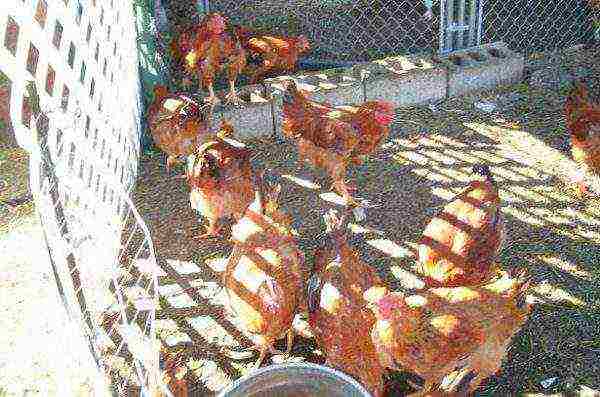
Characteristic
Weight of chickens and roosters
Breeding redbrough chickens is quite a profitable business. The weight of adult chickens reaches 3 kilograms, roosters - 4.5 kilograms, and birds reach this weight by 4-5 months of keeping on conventional feed.
Egg production
On average, one adult hen is capable of laying up to 160 eggs per year. But some layers may have increased egg-laying qualities, allowing up to 250-300 eggs to be harvested per year.
Egg mass
The eggs of redbro hens are medium in size, the color of the eggs is white or light beige. Egg weight is at least 60-70 grams.
Consumption of compound feed per day
To feed one bird, aged:
- from 2 weeks you need at least 100-150 grams of feed per day;
- a three-week-old chicken consumes about 180-200 grams of feed;
- a month-old chicken consumes at least 200-220 grams per day;
- chicks aged 5-6 weeks need an average of 230-240 grams of feed;
- a chicken from 7 to 8 weeks needs to eat at least 245-250 grams of compound feed;
- a half-year-old chicken should be fed 300-350 grams of compound feed per day.
How much feed per egg?
To obtain 1 egg, a chicken must eat at least 50 grams of grain, 30 grams of wet mash, 100 grams of boiled potatoes, 10 grams of oilcakes, 10 grams of hay flour, 100 grams of milk, a few pinches of chalk and table salt. The presence of a permanent source of clean water is mandatory.
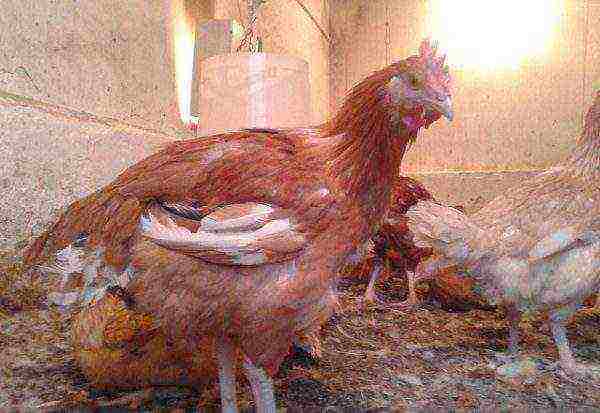
Varieties of red broiler breed
In Russia, one usually does not find the division of redbro chickens into species, but European poultry breeders are well aware of the conventional division of birds into M redbro and C redbro. Both are cultivated by the Hubbard company, the largest poultry farm in France for raising birds of this particular breed.
A variety of redbro M hens is obtained by crossing redbro M layers with redbro roosters. Likewise, it is possible to get redbro S.
Breeding
Day-old redbro chicks should have constant access to fresh milk, cottage cheese and finely chopped greens. An obligatory element of the diet should be a hard-boiled and grated egg. Grown chickens are allowed to be given wet and dry mash.
Adult chickens of the redbro breed are happy to eat chopped vegetables and fruits... If fruit trees grow on the garden plot, chickens can feed on overripe and falling fruits. In addition, it is necessary to provide birds with access to small pebbles, chalk, ash, or shells.
To make the eggshell stronger, potatoes, oilcakes, silage, pine flour and even milk should be added to the usual diet of layers.
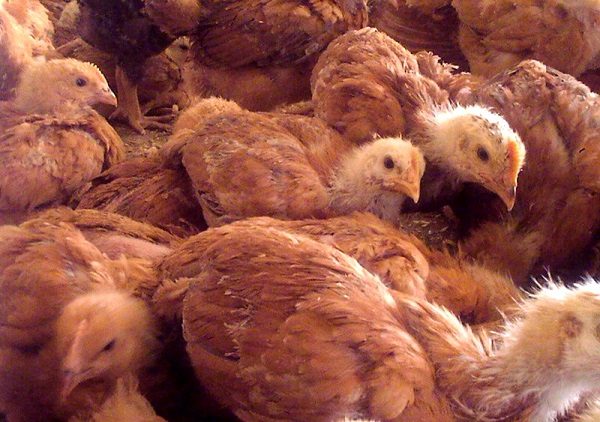
Peculiarities
They keep birds in a regular poultry house, placing the required number of perches, feeders and drinkers in it. A mandatory attribute of the poultry house should be a container with ash and sand, necessary for the chickens to take dry baths, which protect against the appearance of parasites.
The birds are extremely clean, so the house should be cleaned at least once a week, removing the top layer of straw that needs to be laid on the floor, and applying a new one.
Despite the fact that the birds of this cross are considered resistant to various kinds of diseases, it is better to vaccinate the entire livestock in advance, and also to disinfect the room where the chickens will be most of the time.
For disinfection, it is best to use a 2% caustic soda solution, 3% formalin solution, or 3-5% p-creolin solution.
The ceilings and walls of the chicken coop must be whitewashed with lime and left to ventilate for at least a day. Only then can chickens be settled there.
Diseases and treatment
In comparison with broilers, on which this cross looks very much like in external and meat qualities, the latter have a number of invaluable advantages. The most significant of these is resistance to various chicken diseases, such as:
- Typhus. An infectious disease, the symptoms of which are manifested mainly in the digestive tract. The chicken begins to vomit severely, diarrhea is possible. There is a lack of appetite, fever, general weakness. The disease is transmitted by airborne droplets, healthy day old chicks can become infected by eating eggs. Treat the disease with antibiotics.
- Coccidiosis. The cause of the disease is a parasite. The disease is transmitted by direct contact. Its signs are diarrhea, apathy, fever, depression. The main drugs are furagin, zolen and coccidin. The medicine is added to water and food of sick and healthy birds. Most often, the disease affects young animals.
- Pasteurellosis. The first sign of the disease is the blue discoloration of the chicken earrings and scallop. The bird becomes lethargic, diarrhea, mucus from the nose, fever, and swelling in the leg area are observed. They treat the disease with sulfa drugs, simultaneously carrying out a large-scale disinfection of the chicken coop.
- Salmonellosis. Untimely vaccination can lead to infection of birds with salmonellosis. Weakness, apathy, loss of appetite, diarrhea, cessation of growth of young animals, swelling around the eyes are considered signs of the disease. Treat the disease with furazolidone by adding the medicine to drinking water. The course of treatment is 10 days, while it is recommended to isolate diseased birds from healthy ones.
The listed diseases are characteristic of all breeds of birds in general, but redbro chickens are sick with them less often than others, which was taken care of by the creators of the cross.
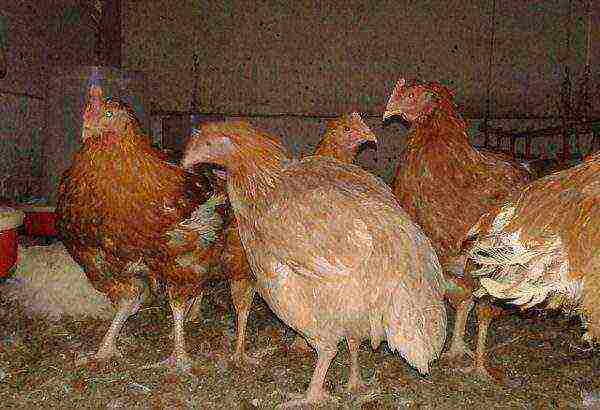
Advantages and disadvantages of the breed
The main advantages of the redbro cross are:
- high survival rate of young animals;
- dietary meat;
- a large number of eggs;
- tendency to fattening;
- the ability to quickly gain weight;
- attractive appearance of birds.
The disadvantage of the breed is its similarity with ordinary Russian yard chickens, which is often used by dishonest sellers.
Reviews about the breed
Evgeniya Viktorovna: Regular red broiler. I liked the taste of the meat, as well as its quantity. As hens, redbro chickens are not bad, I was satisfied with the young growth, despite some loss of the basic qualities of the parents.
Lydia: I bought chickens 3 years ago at one of the agricultural exhibitions in Yaroslavl. I did not notice any negative qualities. The only thing that needs to be carefully monitored is the cleanliness of the chicken coop, redbros practically do not get sick, which makes me very happy.
Valentine:An upscale cross, I have never worked with such a bird before. The meat is simply delicious, despite the slight veins. The taste of eggs is not at all described. I keep chickens in an ordinary bird, their character is peaceful, I have not noticed any problems with getting along, therefore I recommend it to all poultry breeders. Poultry Forum
Conclusion
Chickens redbrough - English cross, bred for the sake of obtaining a large amount of dietary meat in the shortest possible time. The meat and egg qualities of the cross are appreciated in many countries of the world. From one chicken it is possible to get from 160 eggs per year.
